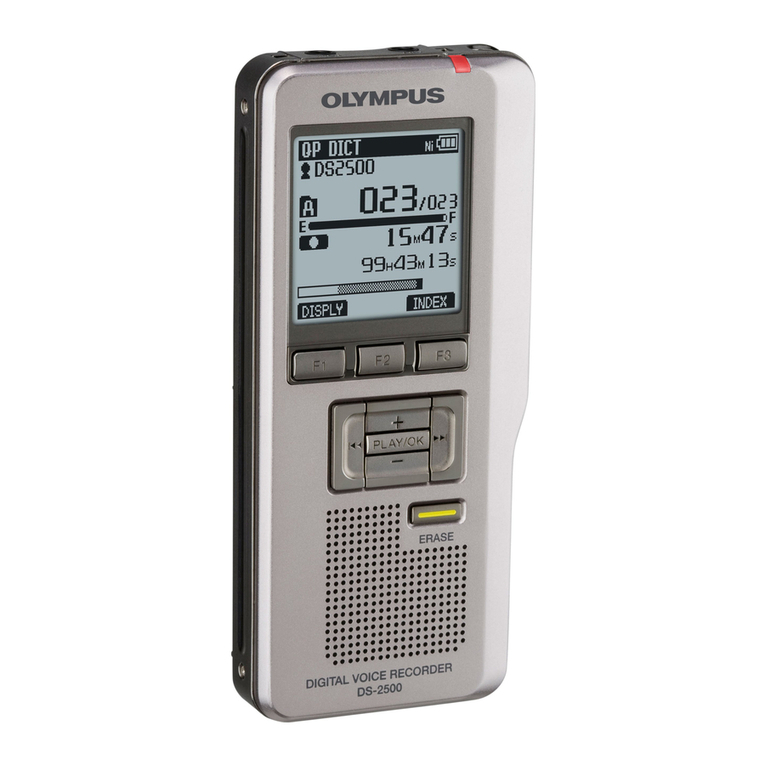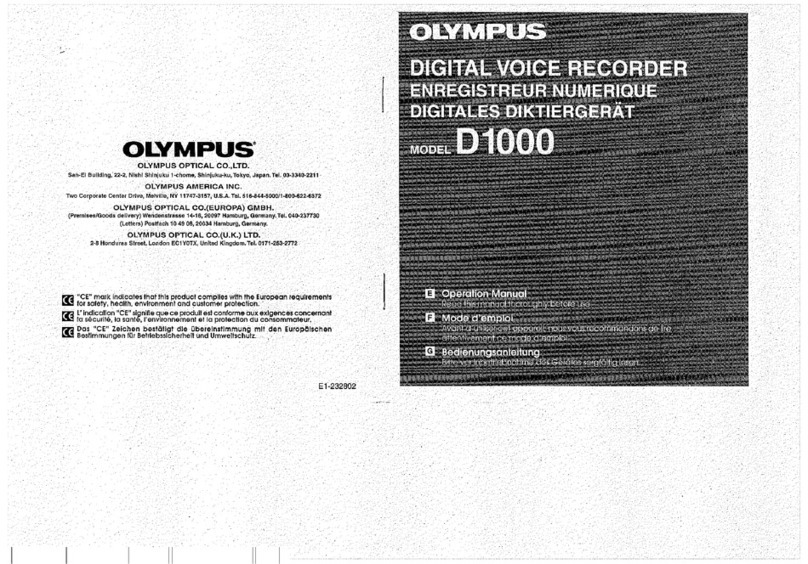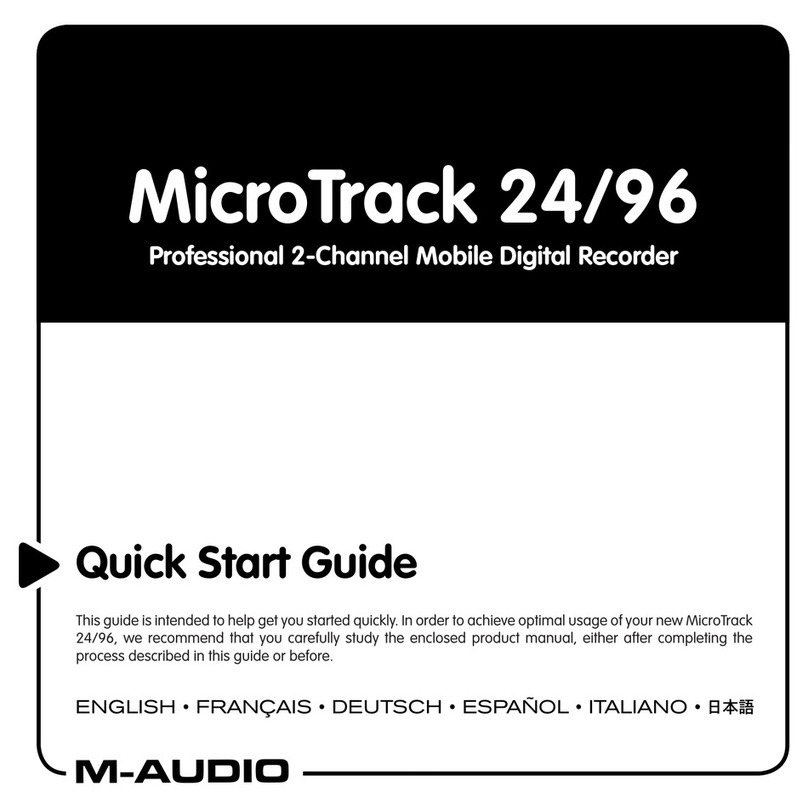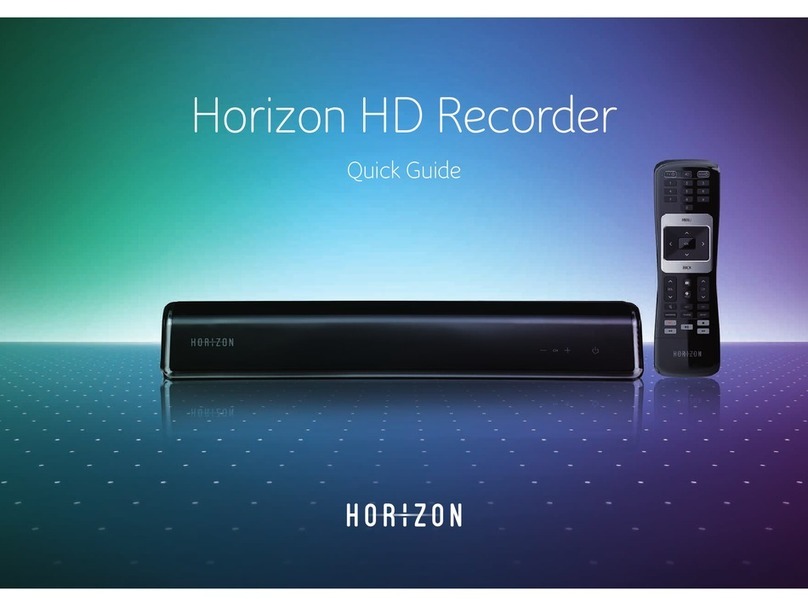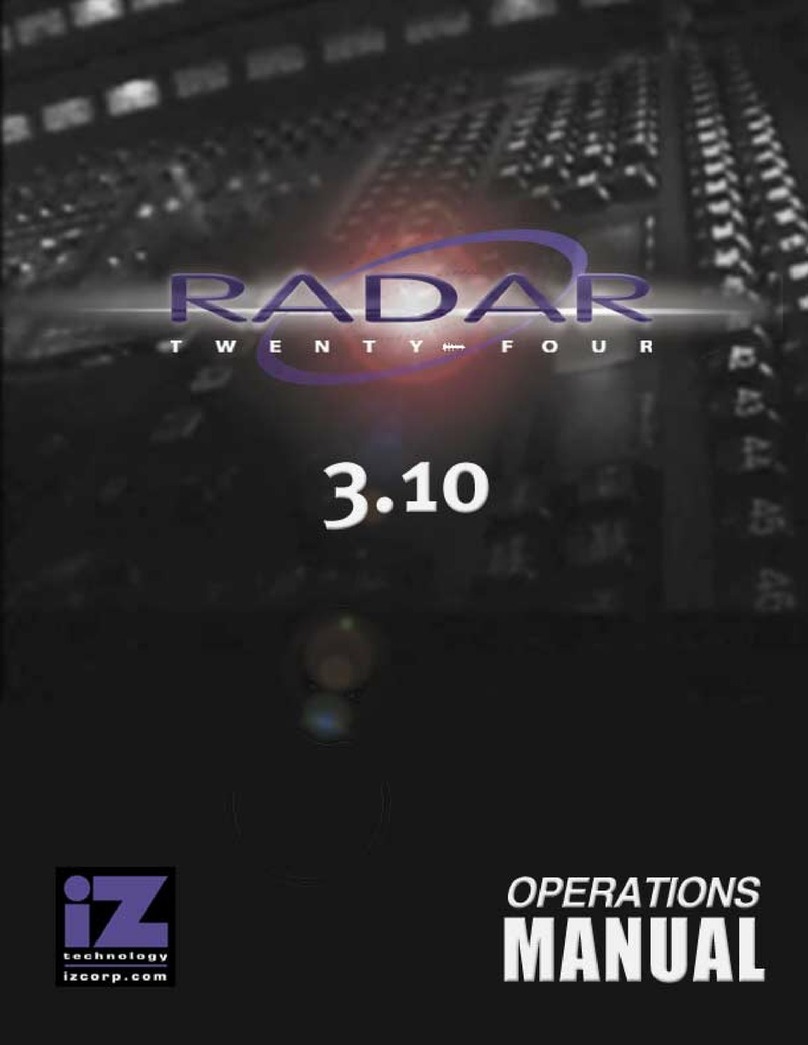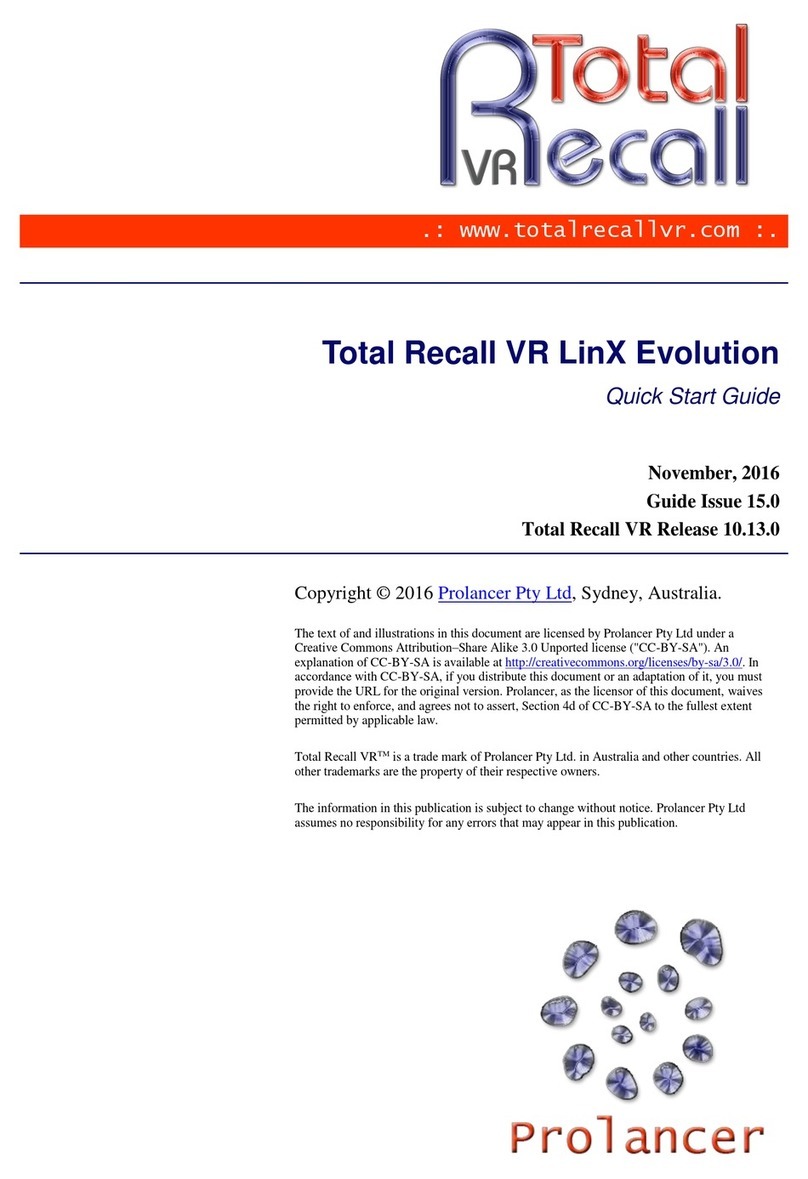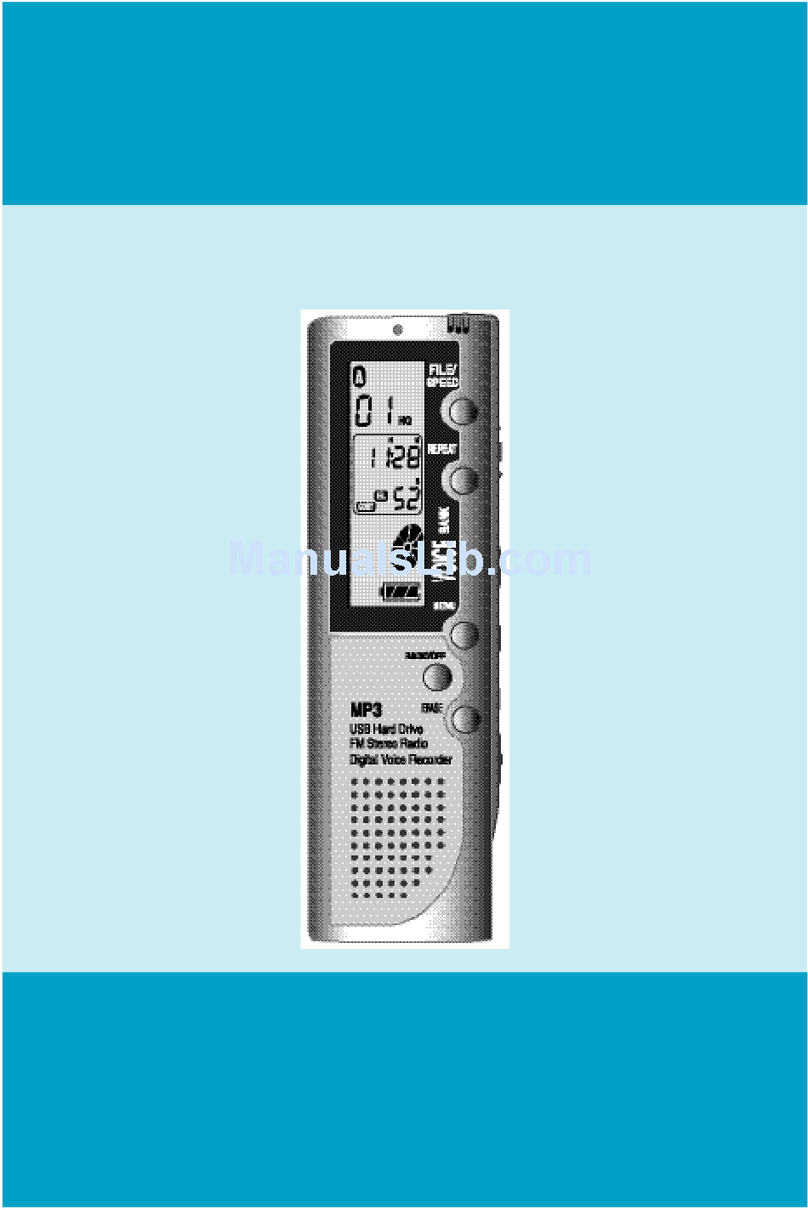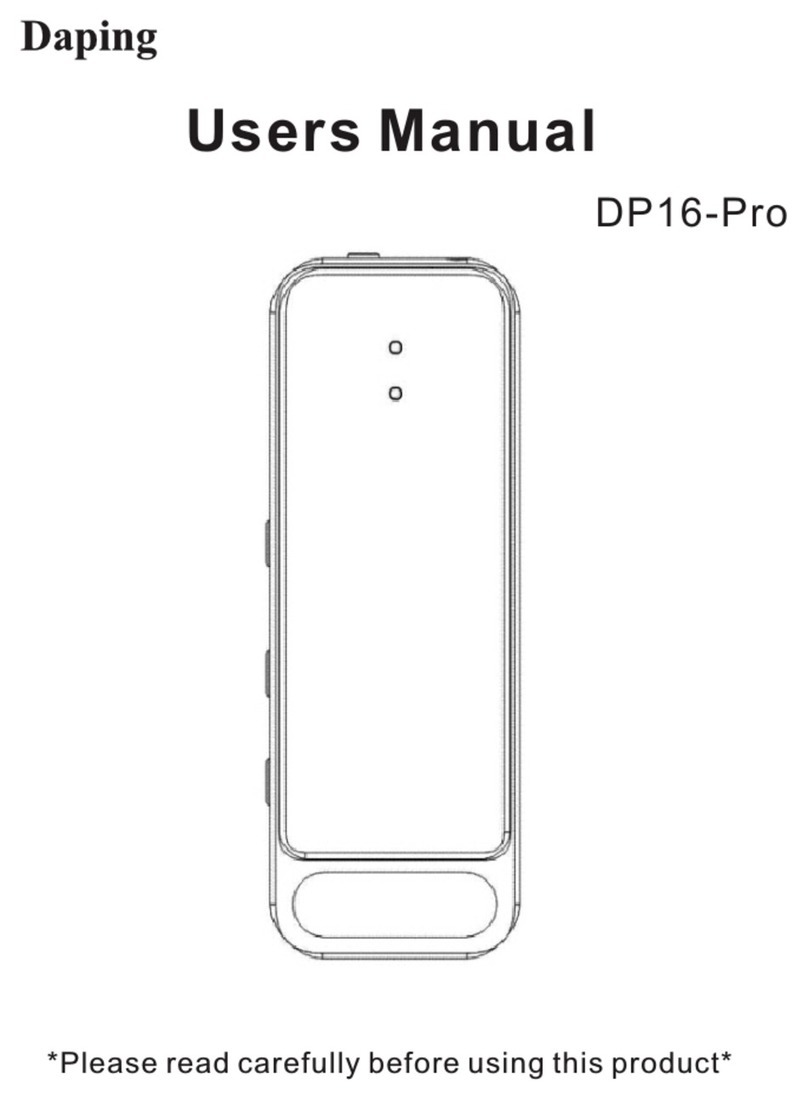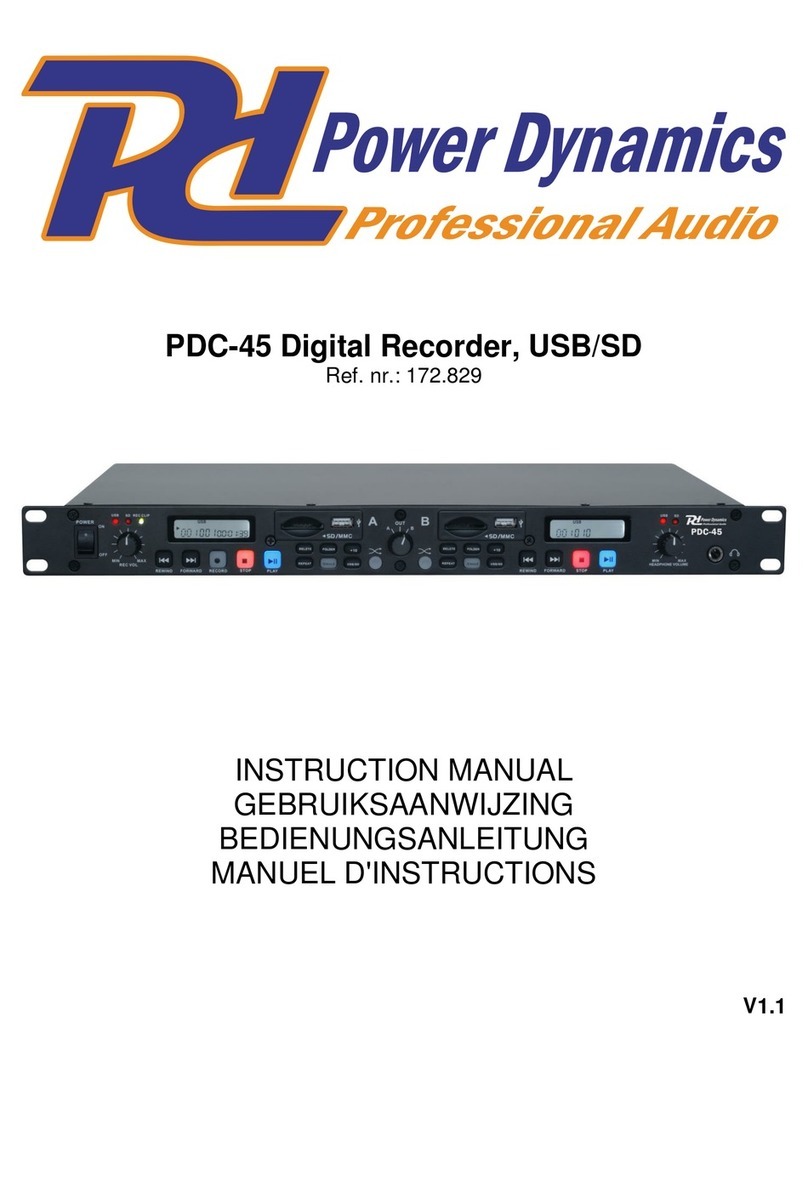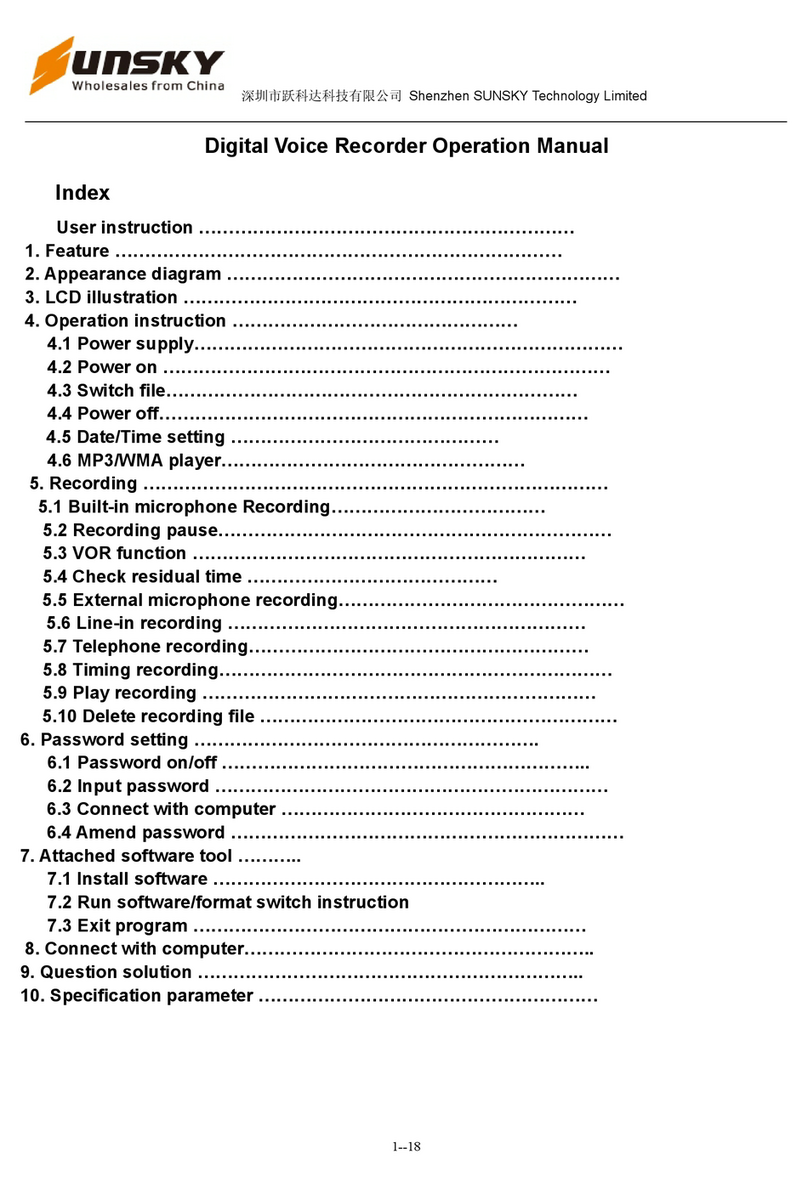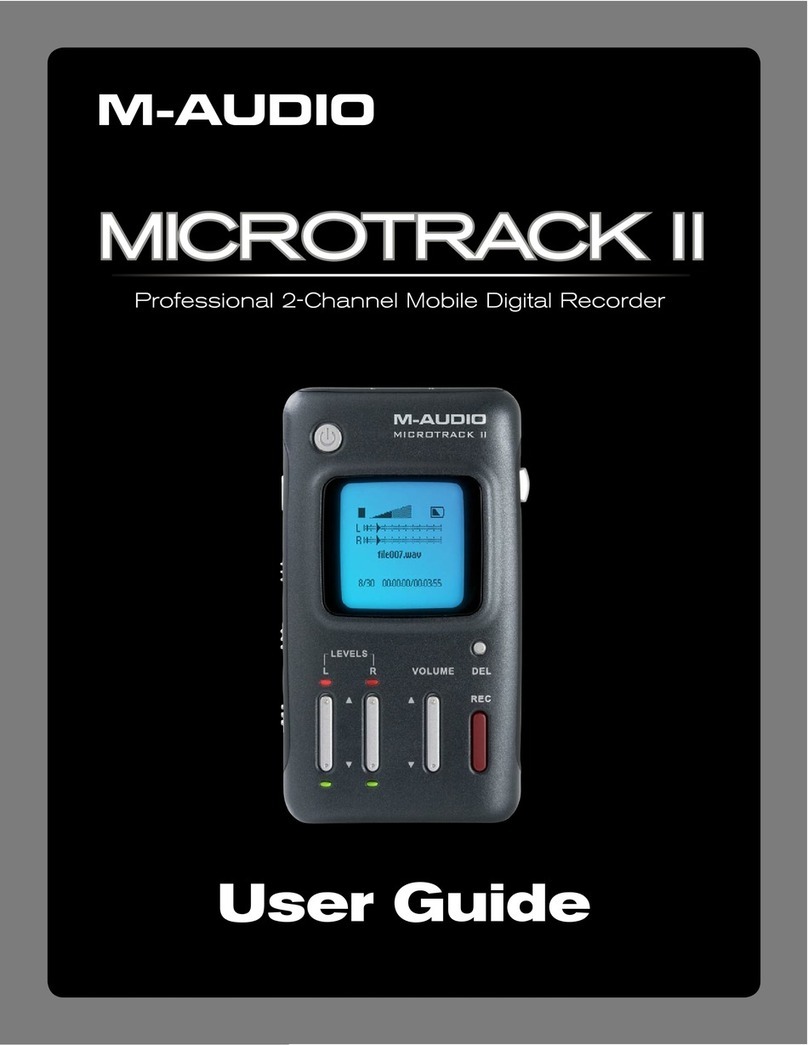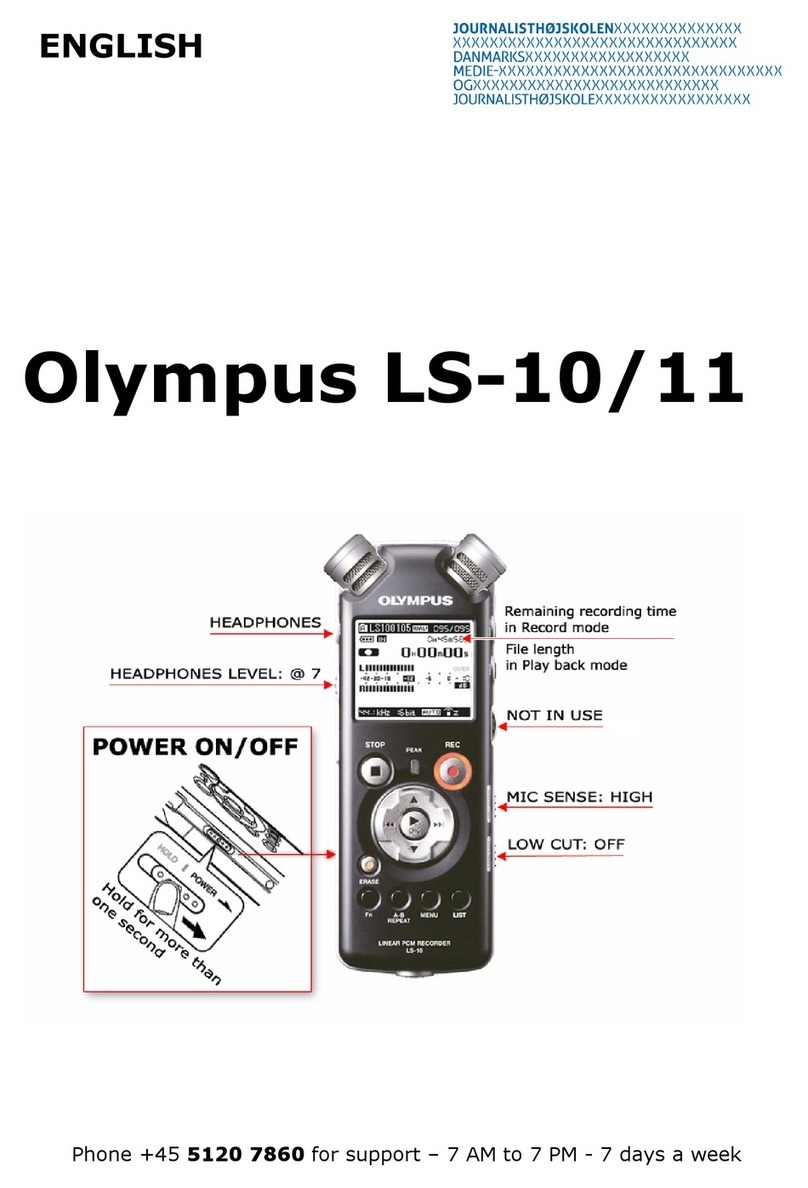IMG STAGE LINE DPR-10 Manual

DPR-10 Best.-Nr. 17.2740
BEDIENUNGSANLEITUNG • INSTRUCTION MANUAL • MODE D’EMPLOI
ISTRUZIONI PER L’USO • GEBRUIKSAANWIJZING • MANUAL DE INSTRUCCIONES
INSTRUKCJA OBSŁUGI • BRUGSANVISNING
MP3-RECORDER
MP3 RECORDER
ENREGISTREUR MP3
REGISTRATORE MP3

2
Bevor Sie einschalten …
Wir wünschen Ihnen viel Spaß mit
Ihrem neuen Gerät von „img Stage
Line“. Bitte lesen Sie diese Bedie-
nungsanleitung vor dem Betrieb
gründlich durch und heben Sie sie für
ein späteres Nachlesen auf.
Der deutsche Text beginnt auf der
Seite 4.
Avant toute installation …
Nous vous souhaitons beaucoup de
plaisir à utiliser votre nouvel appareil
“img Stage Line”. Veuillez lire la pré-
sente notice avec attention avant le
fonctionnement et conservez-la pour
pouvoir vous y reporter ultérieurement.
La version française se trouve page 16.
D
A
CH
F
B
CH
GB
I
Before you switch on …
We hope you will enjoy using your new
“img Stage Line” unit. Please read
these operating instructions carefully
prior to operation and keep them for
later reference.
The English test starts on page 10.
Prima di accendere …
Vi auguriamo buon divertimento con il
vostro nuovo strumento di “img Stage
Line”. Vi preghiamo di leggere atten-
tamente le presenti istruzioni prima
della messa in funzione e di conser-
varle per un uso futuro.
Il testo italiano inizia a pagina 22.
Voor u inschakelt …
Wij wensen u veel plezier met uw
nieuwe apparaat van “img Stage
Line”. Lees deze bedieningshandlei-
ding grondig door, alvorens het appa-
raat in gebruik te nemen, en bewaar
ze voor latere raadpleging.
De Nederlandstalige tekst vindt u op
pagina 28.
NL
B
EAntes de la conexión …
Esperamos que disfrute de su nuevo
aparato “img Stage Line”. Lea atenta-
mente las instrucciones de funciona-
miento antes de utilizar el aparato y
guárdelas para usos posteriores.
La versión española empieza en la
página 34.
Przed włączeniem …
Życzymy zadowolenia z nowego pro-
duktu “img Stage Line”. Przed roz-
poczęciem użytkowania, prosimy za-
poznać się z niniejszą instrukcją ob-
sługi, a następnie zachować ją do
wglądu.
Polski tekst zaczyna się na stronie 40.
PL DK Før du tænder ...
Vi håber, du bliver glad for dit nye “img
Stage Line” produkt. Læs venligst
nærværende brugsanvisning omhyg-
geligt igennem, før produktet tages i
brug; og gem brugsanvisningen til se-
nere brug.
Den danske tekst starter på side 46.
wwwwww..iimmggssttaaggeelliinnee..ccoomm

2 31
5 64
8 97
0
STOP
PROG
FIND
RANDOM
PLAY
PAUSE
REV SKIP CUE
FUNCINTROREPEAT
DELREC
FOLDER
MUTE
PO ER
VOL.
-
VOL.+
3
1 2 3456 78
910111213 14
15 16 17
14
19
13
18
23
8
6
7
20
21
22
11
5
412
3

Auf der ausklappbaren Seite 3 finden Sie
alle beschriebenen Bedienelemente und
Anschlüsse.
1 Übersicht der Bedienelemente
und Anschlüsse
1.1 Frontseite
1USB-Schnittstelle zum Einstecken eines
USB-Sticks
2Display
3Taste DEL zum Löschen einzelner Titel
(Kap. 5.13)
4Taste REC für die Aufnahme- und Kopierfunk-
tion (Kap. 5.11 und Kap. 5.12)
5Taste FUNC zum Umschalten der Signal-
quelle; Anzeige im Display:
USB = USB-Anschluss (1)
CARD = Kartensteckplatz (9)
AUX = Eingang AUX INPUT (17)
6Taste [STOP*] zum Beenden des Abspielens
7Taste [PLAY/PAUSE*] zum Umschalten
zwischen Wiedergabe und Pause
8Tasten [REV*] und [CUE*] für die Titel-
anwahl sowie den schnellen Vor- und Rück-
lauf
Titelanwahl
Mit jedem Drücken der Taste [CUE] wird
ein Titel vorgesprungen; durch Drücken der
Taste [REV] wird an den Titelanfang ge-
sprungen und mit jedem weiteren Drücken
ein Titel zurück.
schneller Vor-/Rücklauf
Für den Vorlauf die Taste [CUE] ge-
drückt halten, für den Rücklauf die Taste
[REV].
9Schlitz zum Einstecken einer SD/MMC-Karte
10 Infrarotsensor für die Fernbedienungssignale
11 Ein-/Ausschalter
12 Tasten VOL zur Einstellung des Ausgangspe-
gels der Buchsen OUTPUT (16)
13 Tasten FOLDER zur Anwahl des ersten Titels
in einem anderen Ordner:
Mit der Taste ▶wird auf den ersten Titel des
nächsten Ordners gesprungen und mit der
Taste ◀auf den ersten Titel des vorherigen
Ordners.
14 Zifferntasten zur Direktanwahl eines Titels, z.B.:
Titelnr. Tasten
4 4, [PLAY/PAUSE*]
27 2, 7,
135 1, 3, 5,
1.2 Rückseite
15 Buchse 12 V für die 12-V-Betriebsspannung
Mittelkontakt = Pluspol
benötigter Kleinspannungsstecker 5,5/2,1 mm
(Außen-/Innendurchmesser)
16 Audioausgang mit Line-Pegel
(linker und rechter Kanal)
17 Aufnahmeeingang AUX INPUT zum An-
schluss einer Signalquelle mit Line-Ausgang
(z. B. CD-Spieler, Radio)
1.3 Fernbedienung
3–8und 11–14
Diese Tasten haben die gleichen Funktionen
wie die Tasten am Gerät.
18 Taste REPEAT für die Wiederholfunktionen
1. Tastendruck (Anzeige REPEAT)
Der momentane Titel wird ständig wieder-
holt.
2. Tastendruck (Anzeige REPEAT ALL)
Alle Titel auf dem Speichermedium werden
ständig wiederholt.
3. Tastendruck (Anzeige REPEAT ALBUM)
Alle Titel im angewählten Ordner werden
ständig wiederholt.
4. Tastendruck (Anzeige REPEAT erlischt)
Die Wiederholfunktion ist ausgeschaltet.
19 Taste INTRO zum Anspielen der Titel für je-
weils 10 Sek. (Anzeige INTRO)
20 Taste PROG, um zum Zusammenstellen einer
eigenen Titelfolge in den Programmiermodus
zu schalten (Kap. 5.10)
21 Taste FIND
– 1. Mal kurz drücken: alphabetische Suche
eines Titels (Kap. 5.4.3)
– 2. Mal kurz drücken: Ordnersuchfunktion
(Kap. 5.4.4)
– 3. Mal kurz drücken: Suchfunktion aus
– 1 Sek. gedrückt halten: Umschalten des
Displays zwischen der Anzeige von Titelin-
formationen (File, Title, Artist, Album) und
der Laufzeit (Titel-Nr., Min. : Sek.)
22 Taste RANDOM zum Abspielen der Titel in zu-
fälliger Reihenfolge (Anzeige RANDOM)
23 Taste MUTE zum Stummschalten
D
A
CH
4
*Beschriftung auf der Fernbedienung

D
A
CH
5
2 Wichtige Hinweise den Gebrauch
Das Gerät entspricht allen relvanten Richtlinien der
EU und ist deshalb mit gekennzeichnet.
Das Gerät ist nur zur Verwendung im Innenbe-
reich geeignet. Schützen Sie es vor Tropf- und
Spritzwasser, hoher Luftfeuchtigkeit und Hitze
(zulässiger Einsatztemperaturbereich 0 – 40 °C).
Verwenden Sie zum Reinigen nur ein trocke-
nes, weiches Tuch, niemals Wasser oder Che-
mikalien.
Wird das Gerät zweckentfremdet, nicht richtig
angeschlossen, falsch bedient oder nicht fach-
gerecht repariert, kann keine Garantie für das
Gerät und keine Haftung für daraus resultie-
rende Sach- oder Personenschäden übernom-
men werden. Ebenso kann keine Haftung fur
durch Fehlbedienung oder durch einen Defekt
entstandene Datenverluste und deren Folge-
schäden ubernommen werden.
3 Einsatzmöglichkeiten
Mit dem MP3-Recorder DPR-10 lassen sich MP3-
und WMA-Dateien (Datenrate max. 256 kb/s) von
USB-Sticks und SD/MMC-Karten (bis 4 GB,
FAT 32) abspielen. Für Aufnahmen im MP3-For-
mat kann ein Audiogerät (Radio, CD-Player, Tape-
Deck usw.) angeschlossen werden. Außerdem
lassen sich Titel von einer SD/MMC-Karte auf
einen USB-Stick kopieren und umgekehrt.
Der DPR-10 kann als separates Gerät betrie-
ben werden, lässt sich aber auch wegen seiner
kompakten Bauform in ein anderes Gerät (z. B. in
eine Aktivlautsprecherbox) einbauen. Beim Ein-
bau muss darauf geachtet werden, dass der MP3-
Recorder ausreichend belüftet wird. Anderenfalls
kann er durch Überhitzung beschädigt werden.
4 Anschlüsse
Vor dem Anschluss bzw. vor dem Verändern von
Anschlüssen den DPR-10 und die anzuschließen-
den Geräte ausschalten.
1) Die Buchsen OUTPUT (16) über ein Cinch-
Kabel mit einem Line-Eingang z. B. an einem
Mischpult oder an einem Verstärker verbinden
(L = linker Kanal, R = rechter Kanal).
2) Sollen Aufnahmen auf eine SD/MMC-Karte
oder auf einen USB-Stick gemacht werden, ein
Audiogerät mit Line-Ausgang (z. B. Radio, CD-
Player, Tape-Deck) an die Buchsen AUX
INPUT (17) anschließen.
3) Zur Stromversorgung wird ein stabilisiertes
12-V-Netzgerät mit einer Dauerbelastbarkeit
von 400 mA und einem Kleinspannungsstecker
mit den Maßen 5,5/2,1 mm (Außen-/Innen-
durchmesser) benötigt (z. B. PSS-1205DC von
MONACOR). Das Netzgerät an die Buchse
12 V (15) anschließen. Dabei auf die richtige
Polung achten: Am Mittelkontakt muss der
Pluspol anliegen!
5 Bedienung
Das Gerät mit der Taste POWER (11) einschalten.
Auf dem Display (2) erscheint zur Begrüßung
HELLO. Wenn der USB-Anschluss (1) nicht mit
einem Speichermedium verbunden ist, wird nach
kurzer Zeit NO USB angezeigt.
5.1 Fernbedienung
1) Zum Einsetzen der Batterien (2 × 1,5 V, Größe
AAA = Mikro) auf der Rückseite der Fernbedie-
nung auf den Pfeil des Deckels drücken und
den Deckel nach unten schieben. Die Batterien,
wie im Batteriefach angegeben, einsetzen. Das
Fach mit dem Deckel wieder schließen.
Bei längerem Nichtgebrauch die Batterien
herausnehmen, damit die Fernbedienung bei
einem eventuellen Auslaufen der Batterien
nicht beschädigt wird.
2) Die Fernbedienung beim Betätigen einer Taste
immer in Richtung des Sensors IR (10) halten.
Dabei muss Sichtverbindung zwischen der
Fernbedienung und dem Sensor bestehen.
3) Lässt die Reichweite der Fernbedienung nach,
sind die Batterien fast verbraucht und müssen
ausgewechselt werden.
Verbrauchte Batterien dürfen nicht in den
Hausmüll geworfen werden. Geben Sie
sie zur umweltgerechten Entsorgung nur
in den Sondermüll (z. B. Sammelbehälter
im Einzelhandel).
Soll das Gerät endgültig aus dem Betrieb
genommen werden, übergeben Sie es
zur umweltgerechten Entsorgung einem
örtlichen Recyclingbetrieb.

5.2 Speichermedium anschließen
und anwählen
1) Zum Abspielen von Audio-Dateien auf einer
SD/MMC-Karte diese in den Schlitz SD MMC
CARD (9) stecken. Dabei muss die abge-
schrägte Ecke der Karte nach rechts und zum
Gerät zeigen.
2) Zum Abspielen von Audio-Dateien auf einem
USB-Stick diesen in den USB-Anschluss (1)
stecken.
3) Nach dem Einschalten wählt das Gerät immer
den USB-Anschluss an. Dabei blinkt im Display
(2) die Anzeige USB. Ist kein Speichermedium
angeschlossen, erscheint die Anzeige NO USB.
Bei angeschlossenem USB-Speicher er-
scheint nach dem Einlesen im Display die An-
zahl der Titel (große Zahl) und die Anzahl der
Ordner (kleine, obere Zahl). Zusätzlich wird
STOP angezeigt, d. h. das Gerät steht auf Stopp.
4) Zum Umschalten zwischen Speicherkarte und
USB-Speicher die Taste FUNC (5) drücken. Mit
dieser Taste wird auch der Eingang AUX
INPUT (17) für MP3-Aufnahmen angewählt
(Kap. 5.11). Das Display zeigt (kurz) die
Auswahl an:
USB = USB-Anschluss
CARD = SD/MMC-Karte
AUX = Eingang AUX INPUT
5.3 Abspielen der Titel
1) Mit der Taste (7) [PLAY/PAUSE*] die Wie-
dergabe des ersten Titels starten. Zum Anwäh-
len eines anderen Titels siehe Kapitel 5.4.
Während des Abspielens zeigt das Display
(2) die Titelnummer an und die bereits gespielte
Zeit des Titels (Min. : Sek.). Die kleine, obere
Zahl gibt die Nummer des Ordners an, in dem
sich der Titel befindet. Titel ohne Ordner befin-
den sich im Hauptverzeichnis ROOT, das mit
der Nummer 1 gekennzeichnet ist.
2) Mit den Tasten VOL (12) den Ausgangspegel
(Lautstärke) so einstellen, dass das an den
Buchsen OUTPUT (16) angeschlossene Gerät
optimal ausgesteuert wird (Anzeige: VOL 00 …
VOL 30). Bei zu hohem Pegel verzerrt das Sig-
nal, bei zu niedrigem Pegel können Störgeräu-
sche hörbar werden.
3) Zum Unterbrechen der Wiedergabe mit der
Taste [PLAY/PAUSE] auf Pause schalten.
Die Zeitanzeige blinkt. Zum Fortsetzen der
Wiedergabe die Taste [PLAY/PAUSE] er-
neut drücken.
4) Sollen anstelle der Zeitanzeige Informationen
zum Titel angezeigt werden, während der Wie-
dergabe eines Titels auf der Fernbedienung die
Taste FIND (21) 1 Sek. gedrückt halten. Im Dis-
play laufen folgende Informationen durch (falls
vorhanden):
FILE* = Dateiname
TITLE = Titelname
ARTIST = Name des Künstlers
ALBUM = Name des Albums
*Wird nur beim Starten der Wiedergabe angezeigt.
Hinweis: Im Pausenmodus zeigt das Display stets
blinkend die bereits gespielte Zeit an.
Genauso kann mit der Taste FIND zurück auf
die Anzeige der Zeit geschaltet werden.
5) Zum Beenden des Abspielens die Taste (6)
[STOP*] drücken. Der Player schaltet auf Stopp
und das Display zeigt STOP an.
5.4 Titelanwahl
5.4.1 Direktwahl der Titelnummer
Mit den Zifferntasten (14) lässt sich ein Titel durch
Eingabe seiner Nummer direkt anwählen. Zum
Starten des Titels anschließend die Taste (7)
[PLAY/PAUSE*] drücken. Beispiele:
Titelnr. Tasten
4 4, [PLAY/PAUSE]
27 2, 7,
135 1, 3, 5,
Hinweis: Die Titel werden vom Gerät wie folgt durch-
nummeriert:
1. alle Titel ohne Ordner im Hauptverzeichnis ROOT
2. alle Titel in Ordnern auf dem Hauptverzeichnis
3. alle Titel in Unterordnern usw.
Die Nummerierung der Ordner erfolgt nicht in alphabeti-
scher Reihenfolge, lässt sich jedoch mit der Ordner-
suchfunktion (Kap. 5.4.4) schnell feststellen. Die
Titelnummern werden auch bei der alphabetischen
Suche von Titeln im Display angezeigt (Kap. 5.4.3).
5.4.2 Titel vor- oder zurückspringen
Um einen oder mehrere Titel vor- oder zurückzu-
springen, die Taste [REV*] bzw. [CUE*] (8)
kurz drücken.
Taste [CUE]: zum nächsten Titel springen
Taste [REV]: an den Anfang des gerade lau-
fenden Titels springen. Durch weiteres Drücken
der Taste [REV] wird immer ein Titel weiter zu-
rückgesprungen.
Hinweis: Die Tasten [REV] und [CUE] nur kurz
drücken, sonst erfolgt ein schneller Rück- bzw. Vorlauf.
D
A
CH
6
*Beschriftung auf der Fernbedienung

5.4.3 Alphabetische Suche von Titeln
1) Auf der Fernbedienung die Taste FIND (21) kurz
drücken. Im Display erscheint blinkend die Lupe
. Die untere Displayzeile zeigt „A–“ und den
ersten Titel, der mit dem Buchstaben A beginnt.
2) Mit der Taste [CUE*] vorwärts laufend oder
[REV*] (8) rückwärts laufend den Buchsta-
ben wählen, mit dem der gesuchte Titel beginnt.
Dabei können auch die Ziffern 0 – 9 gewählt wer-
den. Bei Buchstaben und Ziffern, mit denen kein
Titel beginnt, wird NONE angezeigt.
3) Wenn mehrere Titel mit dem gleichen Anfangs-
buchstaben vorkommen, nach dem Wählen
des Buchstabens die Taste [REV] oder
[CUE] gedrückt halten, bis der Anfangsbuch-
stabe blinkt. Dann durch mehrfaches kurzes
Drücken der Taste [REV] oder [CUE] den
Titel suchen.
4) Bei der Titelsuche wird auch stets die Titelnum-
mer im Display angezeigt (kleine, obere Zahl). Ist
der gewünschte Titel gefunden, die Wiedergabe
mit der Taste (7) [PLAY/PAUSE*] starten.
5.4.4 Ordneranwahl und
Ordnersuchfunktion
Mit den Tasten ◀FOLDER ▶(13) kann auf den
ersten Titel des nächsten Ordners (Taste ▶) und
auf den ersten Titel des vorherigen Ordners
(Taste ◀) gesprungen werden. Ein bestimmter
Ordner lässt sich aber einfacher und schneller mit
der Suchfunktion finden:
1) Auf der Fernbedienung die Taste FIND (21)
zweimal kurz drücken, sodass im Display die
Anzeige ALBUM und der Name des momenta-
nen Ordners erscheint.
Hinweis: Wird die Taste länger als eine Sekunde ge-
drückt, schaltet das Display zwischen Zeitanzeige
und Titelanzeige um (Kap. 5.3, Bedienschritt 4).
2) Mit den Tasten [REV*] und [CUE*] (8)
den gewünschten Ordner suchen. Das Display
zeigt die ersten acht Buchstaben des Ordner-
namens an. Die zugehörige Ordnernummer er-
scheint oben links als kleine Zahl im Display.
3) Ist der gewünschte Ordner gefunden, die Taste
(7) [PLAY/PAUSE*] drücken. Der erste Titel
in diesem Ordner wird gestartet.
4) Zum Anwählen eines anderen Titels die Taste
[CUE] oder [REV] betätigen (Kap.
5.4.2). Vom letzten Titel in einem Ordner kann
mit der Taste [CUE] auch auf den ersten
Titel des nächsten Ordners gesprungen wer-
den und vom ersten Titel in einem Ordner mit
der Taste [REV] auf den letzten Titel des
vorherigen Ordners.
5.5 Schneller Vor-/Rücklauf
Innerhalb eines Titels kann mit dem Vor-/Rücklauf
schnell eine andere Stelle angefahren werden:
Für den schnellen Vorlauf die Taste [CUE*] (8)
gedrückt halten, für den schnellen Rücklauf die
Taste [REV*]. Weil der Vor-/Rücklauf akustisch
nicht verfolgt werden kann, ggf. das Display auf
die Anzeige der Laufzeit umschalten. [Auf der
Fernbedienung die Taste FIND (21) eine Sekunde
gedrückt halten.]
5.6 Wiederholfunktionen
Mit der Taste REPEAT (18) auf der Fernbedienung
kann eine der drei Wiederholfunktionen ausge-
wählt werden:
1. Tastendruck (Anzeige REPEAT)
Der momentane Titel wird ständig wiederholt.
2. Tastendruck (Anzeige REPEAT ALL)
Alle Titel auf dem Speichermedium werden
ständig wiederholt.
3. Tastendruck (Anzeige REPEAT ALBUM)
Alle Titel im angewählten Ordner werden stän-
dig wiederholt.
4. Tastendruck (Anzeige REPEAT erlischt)
Die Wiederholfunktion ist ausgeschaltet.
5.7 Zufallswiedergabe
Sollen die Titel in zufälliger Reihenfolge abge-
spielt werden, auf der Fernbedienung die Taste
RANDOM (22) drücken. Der Player springt auf
einen zufällig ausgewählten Titel und im Display
wird RANDOM angezeigt. Zum Ausschalten der
Funktion die Taste erneut betätigen.
5.8 Titel anspielen
Die Taste INTRO (19) auf der Fernbedienung drü-
cken. Das Gerät spielt alle folgenden Titel für 10
Sekunden an (Anzeige: INTRO). Nach dem An-
spielen des letzten Titels schaltet der Player auf
Stopp und die Anzeige INTRO erlischt. Zum vor-
zeitigen Ausschalten der Funktion die Taste
INTRO erneut betätigen.
5.9 Ton stumm schalten
Um den Ton stumm zu schalten, die Taste MUTE
(23) auf der Fernbedienung drücken. Zum Wie-
dereinschalten des Tons die Taste erneut drücken.
5.10 Eigene Titelfolge zusammenstellen
Soll nur eine Auswahl von Titeln in einer bestimm-
ten Reihenfolge abgespielt werden, kann eine
Folge von max. 64 Titeln programmiert werden.
Zum Programmieren sollte die Nummerierung der
D
A
CH
7

Ordner bekannt sein, denn für jeden zu program-
mierenden Titel muss die zugehörige Nummer
des Ordners eingegeben werden (Kap. 5.4.4).
1) Der Player muss auf Stopp geschaltet sein (An-
zeige STOP), ggf. die Taste [STOP*] (6) drü-
cken.
2) Mit der Taste PROG (20) auf der Fernbedie-
nung den Programmiermodus einschalten. Das
Display zeigt „000 P-01“ und in der oberen
Zeile erscheint die Anzeige PROGRAM.
3) Zuerst die Nummer des Ordners wählen, in
dem sich der erste gewünschte Titel für die Ti-
telfolge befindet. Dieses ist auch erforderlich,
wenn sich alle Titel im Hauptverzeichnis ROOT
ohne Ordner befinden. Das Hauptverzeichnis
hat die Nummer 1.
Die Ordnernummer mit den Tasten
[REV*] und [CUE*] (8) wählen oder mit den
Zifferntasten (14) eingeben. Zum Speichern
dann die Taste PROG drücken. Die drei Nullen
vor der Anzeige „P-01“ blinken als Aufforde-
rung, die Titelnummer einzugeben.
4) Die Nummer des ersten Titels für die Titelfolge
mit den Tasten [REV] und [CUE] wählen
oder mit den Zifferntasten eingeben. Bitte bei
Titeln in Ordnern beachten, dass jetzt nicht alle
Titel auf dem Speichermedium durchnumme-
riert sind, sondern dass jeweils der erste Titel in
einem Ordner die Nummer 1 hat.
5) Zum Speichern die Taste PROG drücken. Das
Display springt auf die nächste Speicherplatz-
nummer „P-02“.
6) Die Bedienschritte 3 – 5 für alle weiteren ge-
wünschten Titel wiederholen, bis die gesamte
Titelfolge programmiert ist.
7) Zum Starten der Titelfolge die Taste (7)
[PLAY/PAUSE*] drücken.
8) Mit den Tasten [REV] und [CUE] kann
jeder Titel der Titelfolge angewählt oder durch
Gedrückthalten der jeweiligen Taste der
schnelle Vor-/Rücklauf innerhalb eines Titels
aktiviert werden.
9) Nach dem Abspielen der Titelfolge oder beim
Drücken der Taste [STOP] schaltet der
Player auf Stopp und die Anzeige PROGRAM
erlischt. Soll die Titelfolge erneut gestartet wer-
den, zuerst die Taste PROG und dann die Taste
[PLAY/PAUSE] drücken.
Hinweis: Eine programmierte Titelfolge wird beim Um-
schalten auf ein anderes Speichermedium, beim Drü-
cken der Taste [STOP] im Programmiermodus und
beim Ausschalten des Gerätes gelöscht.
5.11 Audio-Aufnahmen
1) Am Speichermedium darf der Schreibschutz
nicht aktiviert sein, ggf. den Schutz deaktivie-
ren.
2) Wenn auf einer SD/MMC-Karte aufgenommen
werden soll, darf kein USB-Stick eingesteckt
sein. Bei eingesteckter SD/MMC-Karte und
eingestecktem USB-Stick erfolgt die Aufnahme
immer auf dem USB-Stick.
3) Die Taste FUNC (5) so oft drücken, bis das Dis-
play AUX anzeigt. Damit ist für die Aufnahme
als Signalquelle ein an den Buchsen AUX IN-
PUT (17) angeschlossenes Gerät angewählt.
4) Für die Aufnahme können drei verschiedene
Datenraten eingestellt werden. Folgende Da-
tenraten stehen zur Verfügung:
REC HIGH = 192 kbit/s
REC LOW = 96 kbit/s
REC MID = 128 kbit/s
Nach dem Einschalten des DPR-10 ist immer
REC MID eingestellt.
Um eine andere Datenrate einzustellen, die
Taste REC (4) gedrückt halten: Die nächste
Datenrate ist angewählt und wird im Display
angezeigt. Entweder die angezeigte Datenrate
beibehalten oder durch Antippen der Taste
REC die nächste anwählen. Nach einigen Se-
kunden springt das Display auf die Anzeige
AUX zurück und die zuletzt angezeigte Daten-
rate ist eingestellt.
5) Zum Starten der Aufnahme die Taste REC drü-
cken. Das Gerät bereitet die Aufnahme vor und
im Display blinkt für ca. 3 Sekunden die An-
zeige REC WAIT. Sobald die Aufnahme startet,
erscheint die Anzeige rEC AUX.
Wechselt die Anzeige jedoch auf REC USB,
sind eine SD/MMC-Karte und ein USB-Stick
eingesteckt. Die Aufnahme kann jetzt nur auf
dem USB-Stick erfolgen (siehe Bedienschritt 2)
und startet erst durch erneutes Drücken der
Taste REC.
Hinweis: Erscheint die Anzeige REC NG, wurde die
Aufnahme nicht gestartet oder abgebrochen. Mögli-
che Ursache: Der Schreibschutz ist noch aktiviert,
das Speichermedium ist voll, ein Bedienfehler wurde
gemacht.
6) Während der Aufnahme sind alle Tasten ge-
sperrt, außer REC und [STOP*] (6). Sie die-
nen zum Stoppen der Aufnahme. Nach dem
Beenden der Aufnahme erscheint kurz die An-
zeige REC OK. Dann schaltet das Display auf
die Anzeige AUX zurück.
D
A
CH
8
*Beschriftung auf der Fernbedienung

Hinweise: Für die Aufnahmen legt das Gerät den Ord-
ner TMAUX auf dem Speichermedium an. In diesen
Ordner befinden sich alle eigenen Aufnahmen. Die auf-
genommenen Dateien erhalten den Namen TMAUX mit
dem Zusatz MP3 und eine fortlaufende Nummer, z. B.:
TMAUX001.MP3
TMAUX002.MP3
TMAUX003.MP3
…
Das Datum und die Uhrzeit der Dateien sind jedoch
nicht korrekt. Der Ordnername und die Dateinamen kön-
nen mit einem Computer wie gewünscht umbenannt
werden.
5.12 Titel oder komplette Ordner kopieren
Mit der Kopierfunktion lassen sich einzelne Titel
oder alle Titel eines Ordners von einer SD/MMC-
Karte auf einen USB-Stick kopieren und umge-
kehrt.
1) Mit der Taste FUNC (5) den Speicher anwäh-
len, auf dem sich die zu kopierenden Titel be-
finden (Anzeige CARD oder USB).
2) Wenn das Display nicht STOP anzeigt, das
Gerät mit der Taste [STOP*] (6) auf Stopp
schalten.
3) Die Taste REC (4) drücken. Das Display zeigt
kurz COPY an und springt auf die Anzeige
ALBUM / ROOT um. Die Ordnersuchfunktion ist
aktiviert.
4) Mit der Taste [REV*] bzw. [CUE*] (8) den
Ordner wählen, der kopiert werden soll oder in
dem sich der zu kopierende Titel befindet.
5) Soll der gewählte Ordner kopiert werden, jetzt
die Taste REC erneut drücken oder,
wenn nur ein Titel aus dem gewählten Ordner
kopiert werden soll, die Taste [REV] oder
[CUE] so lange gedrückt halten, bis das Display
auf den Namen des 1. Titels in diesem Ordner
umspringt. Dann durch Antippen der Taste
[REV] oder [CUE] den zu kopierenden Titel
wählen. Das Kopieren mit der Taste REC star-
ten.
6) Während des Kopiervorgangs wechselt die An-
zeige zwischen COPY und dem Namen des
Ordners bzw. der Datei. Alle Tasten außer der
Taste [STOP] (zum Abbrechen des Kopie-
rens) sind gesperrt. Ist der Vorgang beendet,
zeigt das Display kurz COPY OK und wechselt
dann auf STOP. Die kopierten Titel befinden
sich in dem Ordner COPY, der vom Gerät an-
gelegt wurde.
Hinweis: Der Kopiervorgang kann an jeder Stelle der Be-
dienfolge mit der Taste [STOP] abgebrochen werden.
5.13 Einzelne Titel löschen
1) Am Speichermedium darf der Schreibschutz
nicht aktiviert sein, ggf. den Schutz deaktivieren.
2) Wenn das Display nicht STOP anzeigt, das
Gerät mit der Taste [STOP*] (6) auf Stopp
schalten.
3) Die Taste DEL (3) drücken. Das Display zeigt
kurz DELETE an und springt auf die Anzeige
ALBUM / ROOT um. Die Ordnersuchfunktion ist
aktiviert.
4) Mit der Taste [REV*] bzw. [CUE*] (8) den
Ordner wählen, in dem sich der zu löschende
Titel befindet.
5) Ist der Ordner gefunden, die Taste [REV]
oder [CUE] so lange gedrückt halten, bis
das Display auf den Namen des ersten Titels in
diesem Ordner umspringt.
6) Durch Antippen der Taste [REV] oder
[CUE] den zu löschenden Titel wählen.
7) Zum Löschen die Taste DEL drücken. Das Dis-
play zeigt kurz DELETE an und springt auf die
Anzeige STOP zurück.
8) Zum Löschen weiterer Titel die Schritte 3) bis 7)
wiederholen.
Hinweis: Der Löschvorgang kann an jeder Stelle der Be-
dienfolge mit der Taste [STOP] abgebrochen werden.
6 Technische Daten
Frequenzgang: . . . . . . . . . . . 20 – 20 000 Hz
Klirrfaktor: . . . . . . . . . . . . . . . < 0,3 %
Kanaltrennung: . . . . . . . . . . . > 60 dB
Dynamikumfang: . . . . . . . . . > 96 dB
Störabstand: . . . . . . . . . . . . . > 60 dB
Audioausgang: . . . . . . . . . . . 0 – 1,2 V
Stromversorgung: . . . . . . . . . 12 V , 400 mA
Abmessungen (B × H × T): . 175 × 52 × 110 mm
Gewicht: . . . . . . . . . . . . . . . . 545 g
Änderungen vorbehalten.
D
A
CH
9
Diese Bedienungsanleitung ist urheberrechtlich für MONACOR ®INTERNATIONAL GmbH & Co. KG
geschützt. Eine Reproduktion für eigene kommerzielle Zwecke – auch auszugsweise – ist untersagt.

All operating elements and connections
described can be found on the fold-out
page 3.
1 Operating Elements
and Connections
1.1 Front side
1USB interface for inserting a USB stick
2Display
3Button DEL for deleting individual titles
(chapter 5.13)
4Button REC for the recording and copying
functions (chapters 5.11 and 5.12)
5Button FUNC for switching the signal source;
indication in the display:
USB = USB connection (1)
CARD = slot for inserting the card (9)
AUX = input AUX INPUT (17)
6Button [STOP*] to stop the playing
7Button [PLAY/PAUSE*] to switch between
replay and pause
8Buttons [REV*] and [CUE*] for the title
selection and the fast forward and reverse
Title selection
Each time the button [CUE] is pressed,
the unit advances one title; by pressing the
button [REV], the unit goes to the title be-
ginning and with each further pressing, the
unit goes back one more title.
Fast forward/reverse
For the fast forward, keep the button
[CUE] pressed, for the reverse the button
[REV].
9Slot for inserting an SD/MMC card
10 Infrared sensor for the remote control signals
11 POWER switch
12 Buttons VOL for adjusting the output level of
the jacks OUTPUT (16)
13 Buttons FOLDER for selecting the first title in
another folder:
With the button ▶the unit goes to the first title
of the next folder and with the button ◀to the
first title of the previous folder.
14 Numerical keys for direct selection of a title, e. g.
Title No. Buttons
4 4, [PLAY/PAUSE*]
27 2, 7,
135 1, 3, 5,
1.2 Rear panel
15 Jack 12 V for the 12 V operating voltage
centre contact = positive pole
required low voltage plug 5.5/2.1 mm (outside/
inside diameter)
16 Audio output with line level
(left and right channels)
17 Recording input AUX INPUT for connecting a
signal source with line output (e. g. CD player,
radio)
1.3 Remote control
3–8and 11–14
These buttons have the same functions as the
buttons on the unit.
18 Button REPEAT for the repeat functions
1st pressing of button (indication REPEAT)
The present title is continuously repeated.
2nd pressing of button (indication REPEAT ALL)
All titles on the storage medium are contin-
uously repeated.
3rd pressing of button
(indication REPEAT ALBUM)
All titles in the selected folder are continu-
ously repeated.
4th pressing of button
(indication REPEAT is extinguished)
The repeat function is switched off.
19 Button INTRO for playing the beginning of
each title for 10 sec. (indication INTRO)
20 Button PROG for switching to the program-
ming mode to compile an individual title se-
quence (chapter 5.10)
21 Button FIND
– Press shortly for the first time: alphabetic
search of a title (chapter 5.4.3)
– Press shortly for the second time: folder
search function (chapter 5.4.4)
– Press shortly for the third time: search func-
tion off
– Keep it pressed for 1 sec.: the display is
switched between the indication of title in-
formation (file, title, artist, album) and play-
ing time (title No., min. : sec.)
22 Button RANDOM for playing the titles in a ran-
dom sequence (indication RANDOM)
23 Button MUTE for muting
GB
10
*Lettering on the remote control

2 Important Notes
The unit corresponds to all relevant directives of
the EU and is therefore marked with .
The unit is suitable for indoor use only. Protect
it against dripping water and splash water, high
air humidity, and heat (admissible ambient tem-
perature range 0 – 40 °C).
For cleaning only use a dry, soft cloth, never
use chemicals or water.
No guarantee claims for the unit and no liability
for any resulting personal damage or material
damage will be accepted if the unit is used for
other purposes than originally intended, if it is
not correctly connected or operated, or not re-
paired in an expert way. Likewise, no liability for
data loss caused by operating error or by a de-
fect or its consequential damage can be ac-
cepted.
3 Applications
The MP3 recorder DPR-10 allows to replay MP3
and WMA files (data rate 256 kb/s max.) of USB
sticks and SD/MMC cards (up to 4 GB, FAT 32).
For recordings in the MP3 format an audio unit
(radio, CD player, tape deck etc.) may be con-
nected. In addition, it is possible to copy titles from
an SD/MMC card to a USB stick and vice versa.
The DPR-10 can be operated as a separate
unit but due to its compact size it can also be built
into another unit (e. g. into an active speaker sys-
tem). During installation it has to be ensured that
the MP3 recorder will be sufficiently ventilated.
Otherwise it may be damaged by overheating.
4 Connections
Prior to the connection or changing the connec-
tions switch off the DPR-10 and the units to be
connected.
1) Connect the jacks OUTPUT (16) via a cable
with phono connectors to a line input e. g. at a
mixer or amplifier (L = left channel, R = right
channel).
2) For recordings on an SD/MMC card or a USB
stick, connect an audio unit with line output
(e. g. radio, CD player, tape deck) to the jacks
AUX INPUT (17).
3) For power supply a regulated 12 V power
supply unit with a permanent rating of 400 mA
and a low voltage plug of the dimensions
5.5/2.1 mm (outside/inside diameter) is re-
quired (e. g. PSS-1205DC from MONACOR).
Connect the power supply unit to the jack
12 V (15). Observe the correct polarity: The
positive pole must be at the centre contact!
5 Operation
Switch on the unit with the POWER switch (11).
The display (2) shows HELLO as a welcome. If the
USB connection (1) is not connected to a stor-
age medium, NO USB is shown after a short time.
5.1 Remote control
1) To insert the batteries (2 × 1.5 V, size AAA),
press the arrow of the cover on the rear side of
the remote control and slide the cover down-
wards. Insert the batteries as indicated in the
battery compartment. Close the compartment
with the cover.
Remove the batteries if the remote control
will not be used for a longer period of time so
that it will not be damaged in case the batteries
should leak.
2) Always hold the remote control in the direction
of the sensor IR (10) when pressing a button.
There must be no obstacles between the re-
mote control and the sensor.
3) If the range of the remote control decreases,
the batteries are almost exhausted and have to
be replaced.
Do not put exhausted batteries into the
household rubbish but take them to a
special waste disposal (e. g. collective
container at your retailer) for a disposal
which is not harmful to the environment.
If the unit is to be put out of operation de-
finitively, take it to a local recycling plant
for a disposal which is not harmful to the
environment.
GB
11

5.2 Connecting and selecting
a storage medium
1) To replay audio files on an SD/MMC card, in-
sert this card into the slot SD MMC CARD (9).
The bevelled corner of the card must show to
the right and to the unit.
2) To replay audio files on a USB stick, connect
this USB stick to the USB port (1).
3) After switching-on, the unit always selects the
USB connection. USB flashes in the display (2).
If no storage medium has been connected, NO
USB is displayed.
With the USB memory connected, the num-
ber of titles (large number) and the number of
folders (small, upper number) are displayed
after reading in. In addition, STOP is displayed,
i. e. the unit is set to stop.
4) To switch between memory card and USB
memory, press the button FUNC (5). With this
button also the input AUX INPUT (17) for MP3
recordings is selected (chapter 5.11). The
display (shortly) shows the selection:
USB = USB connection
CARD = SD/MMC card
AUX = input AUX INPUT
5.3 Playing the titles
1) With the button (7) [PLAY/PAUSE*] start the
replay of the first title. To select another title,
see chapter 5.4.
While playing, the display (2) shows the title
number and the time already played of the title
(min. : sec.). The small, upper number shows
the number of the folder containing the title. Ti-
tles without folder are in the ROOT directory
marked with No. 1.
2) With the buttons VOL (12) adjust the output
level (volume) so that the unit connected to the
jacks OUTPUT (16) is adjusted to an optimum
level (indication: VOL 00 … VOL 30). If the level
is too high, the signal will be distorted, if the
level is too low, interfering noise may become
audible.
3) To interrupt the replay, set the unit to pause with
the button [PLAY/PAUSE]. The time indica-
tion flashes. To continue the replay, press the
button [PLAY/PAUSE] again.
4) For displaying information about the title in-
stead of the time indication, keep the button
FIND (21) on the remote control pressed for
1 second while playing a title. The display suc-
cessively shows the following information (if
available):
FILE*
TITLE
ARTIST
ALBUM
*Only shown when starting the replay.
Note: In the pause mode the display always shows
the time already played in a flashing way.
With the button FIND it is possible to go back to
the time indication in the same way.
5) To stop the replay, press the button (6)
[STOP*]. The player is set to stop and the dis-
play shows STOP.
5.4 Title selection
5.4.1 Direct selection of the title number
The title can directly be selected by entering its
number with the numerical keys (14). To start the
title, press the button (7) [PLAY/PAUSE*]. Ex-
amples:
Title No. Buttons
4 4, [PLAY/PAUSE]
27 2, 7,
135 1, 3, 5,
Note: The titles are consecutively numbered by the unit
as follows:
1. all titles without folder in the ROOT directory.
2. all titles in folders in the ROOT directory
3. all titles in subfolders etc.
The folders are not numbered in alphabetic order but the
number of the folder can easily be found with the folder
search function (chapter 5.4.4). The title numbers
are also displayed during alphabetic search of titles
(chapter 5.4.3).
5.4.2 Advancing or reversing titles
To advance or reverse one or several titles, shortly
press the button [REV*] or [CUE*] (8).
Button [CUE]: Advance to the next title
Button [REV]: Reverse to the beginning of the
present title. Each time the button [REV] is
pressed, the unit will always go back one more
title.
Note: Press the buttons [REV] and [CUE] only
shortly, otherwise this will result in fast forward or re-
verse.
GB
12
*Lettering on the remote control

GB
13
5.4.3 Alphabetic search of titles
1) Shortly press the button FIND (21) on the re-
mote control. The magnifying glass is dis-
played in a flashing way. The lower display line
shows “A–” and the first title starting with the
letter A.
2) With the button [CUE*] for the search in for-
ward direction or [REV* (8) for the search in
backward direction select the initial letter of the
title searched. The numbers 0 to 9 can be se-
lected as well. NONE is displayed for letters
and numbers not referring to a title beginning.
3) If there are several titles with the same initial
letter, keep the button [REV] or [CUE]
pressed after selecting the letter until the initial
letter flashes. Then look for the title by re-
peated, short pressing of the button [REV]
or [CUE].
4) When looking for the title, always the title num-
ber (small, upper number) is displayed. If the
desired title has been found, start the replay
with the button (7) [PLAY/PAUSE*].
5.4.4 Folder selection and
folder search function
With the buttons ◀FOLDER ▶(13) it is possible to
go to the first title of the next folder (button ▶) and
to the first title of the previous folder (button ◀). A
certain folder can be found easier and quicker with
the search function:
1) The button FIND (21) on the remote control has
shortly to be pressed twice so that the indica-
tion ALBUM and the name of the present folder
are displayed.
Note: If the button is pressed for more than a second,
the display is switched between time indication and
title indication (chapter 5.3, operating step 4).
2) Look for the desired folder with the buttons
[REV*] and [CUE*] (8). The display shows
the first eight letters of the folder name. The
corresponding folder number is shown as a
small number on the top left of the display.
3) If the desired folder has been found, press the
button (7) [PLAY/PAUSE*]. The first title in
this folder is started.
4) To select another title, press the button
[CUE] or [REV] (chapter 5.4.2). With the
button [CUE] it is possible to go from the
last title in a folder to the first title of the next
folder and with the button [REV] from the
first title in a folder to the last title of the previ-
ous folder.
5.5 Fast forward/reverse
With the fast forward/reverse it is possible to
quickly go to another spot within a title: For the
fast forward keep the button [CUE*] (8)
pressed, for the fast reverse the button
[REV*]. As the fast forward/reverse cannot be fol-
lowed acoustically, switch the display to the indi-
cation of the playing time, if required. [Keep the
button FIND (21) on the remote control pressed
for one second.]
5.6 Repeat functions
One of the three repeat functions can be selected
with the button REPEAT (18) on the remote con-
trol:
1st pressing of button (indication REPEAT)
The present title is repeated continuously.
2nd pressing of button (indication REPEAT ALL)
All titles on the storage medium are repeated
continuously.
3rd pressing of button
(indication REPEAT ALBUM)
All titles in the selected folder are repeated
continuously.
4th pressing of button
(indication REPEAT is extinguished)
The repeat function is switched off.
5.7 Random replay
For playing the titles in a random order, press the
button RANDOM (22) on the remote control. The
player goes to a title selected at random and RAN-
DOM is displayed. To switch off the function, press
the button again.
5.8 Short playing of a title beginning
Press the button INTRO (19) on the remote con-
trol. The unit replays each of the following titles for
10 seconds (indication: INTRO). After shortly play-
ing the beginning of the last title, the player will be
switched to stop and the indication INTRO will be
extinguished. To switch off the function before all
titles have been replayed, press the button INTRO
again.
5.9 Muting the sound
To mute the sound, press the button MUTE (23)
on the remote control. To switch the sound on
again, press the button once more.

5.10 Compiling an individual
title sequence
For playing only a selection of titles in a certain
order, a sequence of 64 titles as a maximum can
be programmed. For programming, the numbering
of the folders should be known because the corre-
sponding number of the folder has to be entered for
each title to be programmed (chapter 5.4.4).
1) The player must be set to stop (indication STOP),
press the button [STOP*] (6), if required.
2) Switch on the programming mode with the but-
ton PROG (20) on the remote control. The dis-
play shows “000 P-01” and the indication PRO-
GRAM is shown in the upper line.
3) First select the number of the folder containing
the first desired title for the title sequence. This
is also required if all titles are in the ROOT di-
rectory without folder. The root directory has
the number 1.
Select the folder number with the buttons
[REV*] and [CUE*] (8) or with the numerical
keys (14). To memorize, press the button
PROG. The three zeroes in front of the indica-
tion “P-01” flash as a request to enter the title
number.
4) Select the number of the first title for the title se-
quence with the buttons [REV] and
[CUE] or enter it with the numerical keys. For ti-
tles in folders please observe that not all titles
are consecutively numbered on the storage
medium now but that the first title in a folder has
the number 1 in each case.
5) To memorize, press the button PROG. The dis-
play goes to the next memory location number
“P-02”.
6) Repeat the operating steps 3 to 5 for all further
desired titles until the complete title sequence
will be programmed.
7) To start the title sequence, press the button
(7) [PLAY/PAUSE*].
8) With the buttons [REV] and [CUE] each
title of the title sequence can be selected or, by
keeping the respective button pressed, the fast
forward/reverse within a title can be activated.
9) After playing the title sequence or with pressing
the button [STOP] the player is set to stop
and the indication PROGRAM will be extin-
guished. For starting the title sequence again,
first press the button PROG and then the button
[PLAY/PAUSE].
Note: A programmed title sequence is deleted when
switching to another storage medium, when pressing
the button [STOP] in the programming mode, and
when switching the unit off.
5.11 Audio recordings
1) The write protection of the storage medium
must not be activated, deactivate the protec-
tion, if required.
2) For recording on an SD/MMC card, no USB
stick must be inserted. With SD/MMC card and
USB stick inserted, the recording is always
made on the USB stick.
3) Press the button FUNC (5) so many times until
AUX is displayed. Thus, a unit connected to the
jacks AUX INPUT (17) is selected as a signal
source for the recording.
4) For the recording three different data rates can
be adjusted. The following data rates are avail-
able:
REC HIGH = 192 kbit/s
REC LOW = 96 kbit/s
REC MID = 128 kbit/s
After switching on the DPR-10, always REC
MID is adjusted.
To adjust another data rate, keep the button
REC (4) pressed: the next data rate is selected
and displayed. Either keep the indicated data
rate or select the next one by shortly pressing
the button REC. After a few seconds the display
goes back to the indication AUX and the last
data rate indicated is adjusted.
5) To start the recording, press the button REC.
The unit prepares the recording and REC WAIT
flashes in the display for approx. 3 seconds. As
soon as the recording starts, rEC AUX is dis-
played.
However, if the display changes to REC
USB, an SD/MMC card and a USB stick have
been inserted. The recording can now only be
made on the USB stick (see operating step 2)
and only starts when pressing the button REC
again.
Note: If the indication REC NG is displayed, the
recording was not started or was stopped. Possible
cause: The write protection is still activated, the stor-
age medium is full, an operating error has been
made.
6) While recording, all buttons are locked, except
REC and [STOP*] (6). They serve to stop the
recording. After terminating the recording, the
indication REC OK is shortly displayed. Then
the display is switched back to the indication
AUX.
GB
14
*Lettering on the remote control

Notes: For the recordings the unit creates the folder
TMAUX on the storage medium. This folder contains all
individual recordings. The recorded files receive the
name TMAUX with the extension MP3 and a consecu-
tive number, for example:
TMAUX001.MP3
TMAUX002.MP3
TMAUX003.MP3
…
The date and the time of the files are, however, not cor-
rect. The folder name and the file names can be re-
named with a computer as desired.
5.12 Copying titles or complete folders
With the copying function individual titles or all ti-
tles of a folder can be copied from an SD/MMC
card to a USB stick and vice versa.
1) With the button FUNC (5) select the memory
containing the titles to be copied (indication
CARD or USB).
2) If the display does not show STOP, set the unit
to stop with the button [STOP*] (6).
3) Press the button REC (4). The display shortly
shows COPY and then the indication ALBUM
ROOT. The folder search function is activated.
4) With the button [REV*] or [CUE*] (8) se-
lect the folder to be copied or the folder con-
taining the title to be copied.
5) For copying the selected folder, press the but-
ton REC again or,
for only copying one title from the selected
folder, keep the button [REV] or [CUE]
pressed until the display goes to the name of
the first title in this folder. Select the title to be
copied by shortly pressing the button [REV]
or [CUE]. Start to copy with the button REC.
6) While copying, the indication changes between
COPY and the name of the folder or file. All but-
tons except the button [STOP] (to stop copy-
ing) are locked. If the procedure is terminated,
the display shortly shows COPY OK and then
changes to STOP. The titles which have been
copied are in the folder COPY created by the
unit.
Note: Copying can be stopped at any step of the oper-
ating sequence with the button [STOP].
5.13 Deleting individual titles
1) The write protection at the storage medium
must not be activated, deactivate the protec-
tion, if required.
2) If the display does not show STOP, set the unit
to stop with the button [STOP*] (6).
3) Press the button DEL (3). The display shortly
shows DELETE and goes to the indication
ALBUM / ROOT. The folder search function is
activated.
4) With the button [REV*] or [CUE*] (8) se-
lect the folder containing the title to be deleted.
5) When the folder has been found, keep the but-
ton [REV] or [CUE] pressed until the dis-
play shows the name of the first title in this
folder.
6) By shortly pressing the button [REV] or
[CUE] select the title to be deleted.
7) To delete, press the button DEL. The display
shortly shows DELETE and returns to the indi-
cation STOP.
8) To delete further titles, repeat the steps 3) to 7).
Note: Deleting can be stopped at any step of the oper-
ating sequence with the button [STOP].
6 Specifications
Frequency response: . . . . . . 20 – 20 000 Hz
THD: . . . . . . . . . . . . . . . . . . . < 0.3 %
Channel separation: . . . . . . . > 60 dB
Dynamic range: . . . . . . . . . . > 96 dB
S/N ratio: . . . . . . . . . . . . . . . > 60 dB
Audio output: . . . . . . . . . . . . 0 – 1.2 V
Power supply: . . . . . . . . . . . . 12 V , 400 mA
Dimensions (W × H × D): . . . 175 × 52 × 110 mm
Weight: . . . . . . . . . . . . . . . . . 545 g
Subject to technical modifications.
GB
15
All rights reserved by MONACOR ®INTERNATIONAL GmbH & Co. KG. No part of this instruction
manual may be reproduced in any form or by any means for any commercial use.

Vous trouverez sur la page 3, dépliable, les
éléments et branchements décrits.
1 Eléments et branchements
1.1 Face avant
1Interface USB pour insérer une clé USB
2Affichage
3Touche DEL pour effacer un titre (chapi-
tre 5.13)
4Touche REC pour les fonctions Enregistre-
ment et Copie (chapitres 5.11 et 5.12)
5Touche FUNC pour commuter la source de si-
gnal ; sur lʼaffichage :
USB = port USB (1)
CARD = emplacement pour carte (9)
AUX = entrée AUX INPUT (17)
6Touche [STOP*] pour arrêter la lecture
7Touche [PLAY/PAUSE*] pour commuter
entre lecture et pause
8Touches [REV*] et [CUE*] pour la sé-
lection de titres et lʼavance et retour rapides
sélection de titres : à chaque pression sur la
touche [CUE], on avance dʼun titre ; en
appuyant sur la touche [REV] on saute
au début du titre et à chaque autre pres-
sion, on recule dʼun titre.
avance et retour rapides : pour lʼavance ra-
pide, maintenez la touche [CUE] enfon-
cée, pour le retour rapide, maintenez la
touche [REV] enfoncée.
9Fente pour insérer une carte SD/MMC
10 Capteur infrarouge pour les signaux de la télé-
commande
11 Interrupteur Marche/Arrêt
12 Touches VOL pour régler le niveau de sortie
des prises OUTPUT (16)
13 Touches FOLDER pour sélectionner le pre-
mier titre dans un autre dossier :
avec la touche ▶, on va au premier titre du
dossier suivant et avec la touche ◀, au pre-
mier titre du dossier précédent.
14 Touches numériques pour la sélection directe
dʼun titre, par exemple
Numéro du titre Touches
4 4, [PLAY/PAUSE*]
27 2, 7,
135 1, 3, 5,
1.2 Face arrière
15 Prise 12 V pour la tension de fonctionnement
12 V
contact médian = pôle plus
Adaptateur nécessaire 5,5/2,1 mm (diamètre
extérieur/diamètre intérieur)
16 Sortie audio avec niveau ligne
(canal gauche et canal droit)
17 Entrée enregistrement AUX INPUT pour bran-
cher une source audio avec sortie ligne (par
exemple lecteur CD, radio)
1.3 Télécommande
3–8et 11–14
Ces touches ont les mêmes fonctions que les
touches sur lʼappareil.
18 Touche REPEAT pour les fonctions de répéti-
tion :
1. pression (affichage REPEAT)
titre en cours répété en continu.
2. Pression (affichage REPEAT ALL)
tous les titres du support de mémoire sont
répétés en continu.
3. pression (affichage REPEAT ALBUM)
tous les titres dans le dossier sélectionné
sont répétés en continu.
4. pression (affichage REPEAT éteint)
la fonction Répétition est déconnectée.
19 Touche INTRO pour lire les premières notes
dʼun titre pendant 10 secondes (affichage
INTRO)
20 Touche PROG pour créer, en mode program-
mation, une suite de titres (chapitre 5.10)
21 Touche FIND
– première pression brève : recherche alpha-
bétique dʼun titre (chapitre 5.4.3)
– deuxième pression brève : fonction re-
cherche de dossier activée (chapi-
tre 5.4.4)
– troisième pression brève : fonction re-
cherche désactivée
– touche enfoncée une seconde : commuta-
tion de lʼaffichage entre lʼindication des in-
formations du titre (File, Title, Artist, Album)
et la durée (numéro du titre, minutes : se-
condes)
22 Touche RANDOM pour lire les titres en ordre
aléatoire (affichage RANDOM)
23 Touche MUTE pour couper le son
F
B
CH
16
*Inscription sur la télécommande

2 Conseils dʼutilisation importants
Cet appareil répond à toutes les directives néces-
saires de lʼUnion Européenne et porte donc le
symbole .
Lʼappareil nʼest conçu que pour une utilisa-
tion en intérieur. Protégez-le de tout type de
projections dʼeau, des éclaboussures, dʼune
humidité élevée de lʼair et de la chaleur
(plage de température de fonctionnement
autorisée : 0 – 40 °C).
Pour le nettoyage utilisez uniquement un
chiffon doux et sec, en aucun cas de pro-
duits chimiques ou dʼeau.
Nous déclinons toute responsabilité en cas
de dommages matériels ou corporels résul-
tants si lʼappareil est utilisé dans un but
autre que celui pour lequel il a été conçu, sʼil
nʼest pas correctement branché, utilisé ou
nʼest pas réparé par une personne habilitée,
en outre, la garantie deviendrait caduque.
De même, nous déclinons toute responsabi-
lité en cas de pertes de données causées
par une mauvaise manipulation ou un dé-
faut, et leurs conséquences.
3 Possibilités dʼutilisation
Lʼenregistreur MP3 DPR-10 permet de lire des fi-
chiers MP3 et WMA (taux de données 256 kb/s
max.) de clés USB et de cartes SD/MMC (jusquʼà
4 GO, FAT 32). Pour des enregistrements MP3, on
peut relier un appareil audio (radio, lecteur CD,
tape deck etc). De plus, on peut copier des titres
dʼune carte SD/MMC sur une clé USB et inverse-
ment.
Le DPR-10 peut fonctionner seul, il peut égale-
ment être intégré dans un autre appareil grâce à
sa forme compacte (par exemple dans une en-
ceinte active). Si vous lʼinsérez, veillez à ce que le
lecteur MP3 soit suffisamment ventilé, sinon il y a
risque de surchauffe et cela pourrait endommager
lʼappareil.
4 Branchements
Avant dʼeffectuer ou de modifier les branche-
ments, assurez-vous que lʼappareil et les appa-
reils à relier sont éteints.
1) Reliez les prises OUTPUT (16) via un cordon
RCA à une entre ligne, p. ex. à une table de
mixage ou un amplificateur (L = canal gauche,
R = canal droit).
2) Si des enregistrements sur une carte SD/MMC
ou une clé USB doivent être effectués, reliez un
appareil audio avec sortie ligne (p. ex. radio,
lecteur CD, tape deck) aux prises AUX INPUT
(17).
3) Pour lʼalimentation, une alimentation stabilisée
12 V avec une charge continue de 400 mA et un
adaptateur 5,5/2,1 mm (∅extérieur/∅intérieur)
est nécessaire (par exemple PSS-1205DC de
MONACOR). Reliez lʼalimentation à la prise
12 V (15). Veillez à respecter la polarité : pôle
plus au contact médian.
5 Utilisation
Allumez lʼappareil avec la touche POWER (11)
Sur lʼaffichage (2), HELLO est visible. Si le port
USB (1) nʼest pas relié à un support de mémoire.
NO USB sʼaffiche peu de temps après.
5.1 Télécommande
1) Pour insérer les batteries (2 × 1,5 V, type R03),
appuyez sur la flèche du couvercle sur la face
arrière de la télécommande et poussez le cou-
vercle vers le bas. Insérez les batteries comme
indiqué dans le compartiment. Refermez le
compartiment batterie avec le couvercle.
En cas de non utilisation prolongée, retirez
les batteries, elles pourraient couler et endom-
mager la télécommande.
2) Maintenez la télécommande toujours en direc-
tion du capteur infrarouge IR (10) lorsque vous
activez une touche. Il ne faut aucun obstacle
entre la télécommande et le capteur.
3) Si la portée de la télécommande diminue, les
batteries sont vraisemblablement épuisées et
doivent être remplacés.
Ne jetez pas les batteries usagées dans
la poubelle domestique. Pour une élimi-
nation écologique, déposez-les dans un
container spécifique ou ramenez-les chez
votre détaillant.
Lorsque lʼappareil est définitivement retiré
du service, vous devez le déposer dans
une usine de recyclage adaptée pour
contribuer à son élimination non polluante.
F
B
CH
17

5.2 Connexion et sélection de support
de mémoire
1) Pour lire des fichiers audio sur une carte
SD/MMC, insérez la carte dans la fente SD
MMC CARD (9). Le coin oblique de la carte doit
être vers la droite et vers lʼappareil.
2) Pour lire des données audio sur une clé USB,
on peut connecter cette clé USB dans le port
USB (1).
3) Une fois allumé, lʼappareil sélectionne toujours
le port USB. Sur lʼaffichage (2), lʼindication USB
clignote. Si aucun support de mémoire nʼest
relié, NO USB sʼaffiche.
Lorsquʼun support USB de mémoire est
relié, le nombre de titres (grand chiffre), le nom-
bre de dossiers (petit chiffre supérieur) sʼaffi-
chent après la reconnaissance du fichier.
STOP sʼaffiche, cʼest-à-dire que lʼappareil est
sur Stop.
4) Pour commuter entre une carte mémoire et un
support USB, appuyez sur la touche FUNC (5).
Vous pouvez également, avec cette touche, sé-
lectionner lʼentrée AUX INPUT (17) pour des
enregistrements MP3 (chapitre 5.11). Lʼaffi-
chage indique (brièvement) la sélection :
USB = port USB
CARD = fente pour carte SD/MMC
AUX = entrée AUX INUT
5.3 Lecture de titres
1) Avec la touche (7) [PLAY/PAUSE*], démar-
rez la lecture du premier titre. Pour sélectionner
un autre titre, voir chapitre 5.4.
Pendant la lecture, lʼaffichage (2) indique le
numéro du titre et la durée déjà lue du titre (mi-
nutes : secondes). Le petit chiffre supérieur in-
dique le numéro du dossier dans lequel le titre
se trouve. Les titres sans dossier sont dans le
répertoire principal ROOT, repéré par le nu-
méro 1.
2) Avec les touches VOL (12), réglez le niveau de
sortie (volume) de telle sorte que lʼappareil relié
aux prises OUTPUT (16) soit géré de manière
optimale (affichage : VOL 00 … VOL 30). Si le
niveau est trop élevé, le signal est distordu, si
le niveau est trop faible, des interférences peu-
vent être audibles.
3) Pour interrompre la lecture, passez sur pause
avec la touche [PLAY/PAUSE]. Lʼindication
de temps clignote. Pour poursuivre la lecture,
appuyez une nouvelle fois sur la touche
[PLAY/PAUSE].
4) Si des informations sur le titre doivent être affi-
chées à la place des informations de durée,
pendant la lecture dʼun titre, maintenez la
touche FIND (21) sur la télécommande enfon-
cée 1 seconde. Sur lʼaffichage, les informations
suivantes, si existantes, défilent :
FILE* = nom du fichier
TITLE = nom du titre
ARTIST = nom de lʼartiste
ALBUM = nom de lʼalbum
*affiché uniquement lors du démarrage de la lecture
Remarque : en mode Pause, lʼaffichage indique tou-
jours, en clignotant la durée déjà lue.
Avec la touche FIND, il est également possible
de revenir à lʼaffichage de la durée.
5) Pour arrêter la lecture, appuyez sur la touche
(6) [STOP*]. Le lecteur commute sur Stop et
lʼaffichage indique STOP.
5.4 Sélection de titres
5.4.1 Sélection directe du numéro du titre
Sélectionnez directement le titre voulu avec les
touches numériques (14) en tapant son numéro.
Pour démarrer le titre, appuyez ensuite sur la
touche (7) [PLAY/PAUSE*]. Exemples :
numéro titre touches
4 4, [PLAY/PAUSE]
27 2, 7,
135 1, 3, 5,
Remarque : les titres sont numérotés consécutivement
par lʼappareil comme suit :
1. tous les titres sans dossier dans le répertoire principal
ROOT
2. tous les titres dans le répertoire principal
3. touts les titres dans les sous dossiers etc.
La numérotation des dossiers ne sʼeffectue pas en ordre
alphabétique, mais le numéro du dossier peut être
trouvé facilement avec la fonction de recherche de dos-
sier (chapitre 5.4.4). Les numéros des titres sont af-
fichées en ordre alphabétique pendant la recherche de
titres (chapitre 5.4.3).
5.4.2 Avance et retour de titres
Pour avancer ou reculer dʼun ou plusieurs titres,
appuyez brièvement sur la touche [REV*] ou
[CUE*] (8).
touche [CUE] : saut au titre suivant
touche [REV] : saut au début du titre en cours.
Par une autre pression sur la touche [REV], on
recule toujours dʼun titre.
Conseil : nʼappuyez que brièvement sur les touches
[REV] et [CUE] sinon on a une avance/un retour ra-
pide.
F
B
CH
18
*Inscription sur la télécommande

5.4.3 Recherche alphabétique de titres
1) Appuyez brièvement sur la touche FIND (21)
sur la télécommande. Sur lʼaffichage la loupe
clignote. La ligne dʼaffichage inférieure indique
“A–” et le premier titre qui commence avec la
lettre A démarre.
2) Avec la touche [CUE*] (recherche en avant)
ou la touche [REV*] (8) (recherche en ar-
rière), sélectionnez la lettre avec laquelle le titre
recherché commence. Vous pouvez également
sélectionner les chiffres 0 à 9. NONE sʼaffiche
pour les lettres et chiffres avec lesquels aucun
titre ne commence.
3) Si plusieurs titres ont la même lettre de début,
maintenez la touche [REV] ou [CUE] en-
foncée après la sélection de la lettre jusquʼà ce
que la lettre de début clignote. Ensuite, par plu-
sieurs brèves pressions sur la touche [REV]
ou [CUE], recherchez le titre.
4) Lors de la recherche de titre, le numéro du titre
est toujours affiché (petit chiffre supérieur).
Lorsque le titre voulu est trouvé, démarrez la
lecture avec la touche (7) [PLAY/PAUSE *].
5.4.4 Sélection de dossier et fonction de
recherche de dossiers
Avec les touches ◀FOLDER ▶(13), on peut sau-
ter au premier titre du dossier suivant (touche ▶)
et au premier titre du dossier précédent (touche
◀). On peut trouver facilement et rapidement un
dossier donné avec la fonction de recherche :
1) Appuyez brièvement deux fois sur la touche
FIND (21) sur la télécommande de telle sorte
que ALBUM et le nom du dossier en cours
soient visibles sur lʼaffichage.
Remarque : si la touche est maintenue enfoncée
plus dʼune seconde, lʼaffichage commute entre lʼindi-
cation de titre et lʼindication de durée (chapi-
tre 5.3, point 4).
2) Avec les touches [REV*] ou [CUE*] (8),
recherchez le dossier voulu. Lʼaffichage in-
dique les huit premières lettres du nom du
dossier. Le numéro du dossier correspondant
sʼaffiche en haut à gauche sous forme de petit
chiffre.
3) Si le dossier souhaité est trouvé, appuyez sur
la touche (7) [PLAY/PAUSE*]. Le premier
titre dans ce dossier démarre.
4) Pour sélectionner un autre titre, appuyez
sur la touche [CUE] ou [REV] (cha-
pitre 5.4.2). Avec la touche [CUE], on peut
sauter du dernier titre dans un dossier au pre-
mier titre du dossier suivant et avec la touche
[REV] du premier titre dans un dossier au
dernier titre du dossier précédent.
5.5 Avance et retour rapides
Au sein dʼun titre, on peut avec lʼavance et retour
aller rapidement à un autre endroit : pour lʼavance
rapide, maintenez la touche [CUE*] (8) enfon-
cée, pour un retour rapide, la touche [REV*].
Dans la mesure où lʼavance/retour ne peut pas
être suivie acoustiquement, si besoin, commutez
lʼaffichage sur lʼindication de la durée. [Sur la télé-
commande, maintenez la touche FIND (21) en-
foncée une seconde].
5.6 Fonctions répétition
Avec la touche REPEAT (18) sur la télécom-
mande, on peut activer une des 3 fonctions répé-
tition :
1. pression (affichage REPEAT) :
titre en cours répété en continu.
2. Pression (affichage REPEAT ALL) :
tous les titres du support de mémoire sont ré-
pétés en continu.
3. pression (affichage REPEAT ALBUM) :
tous les titres dans le dossier sélectionné sont
répétés en continu.
4. pression (affichage REPEAT éteint) :
la fonction Répétition est désactivée.
5.7 Lecture aléatoire
Si des titres doivent être lus en ordre aléatoire, ap-
puyez sur la touche RANDOM (22) sur la télé-
commande. Le lecteur saute à un titre sélectionné
aléatoirement, RANDOM sʼaffiche. Pour désacti-
ver la fonction, appuyez une nouvelle fois sur la
touche.
5.8 Lecture des premières notes
dʼun titre
Appuyez sur la touche INTRO (19) sur la télécom-
mande. Lʼappareil lit tous les titres suivants pen-
dant 10 secondes (affichage : INTRO). Après la
lecture des premières notes du dernier titre, le lec-
teur passe sur Stop, INTRO sʼéteint. Pour désac-
tiver la fonction avant que tous les titres ne soient
lus, appuyez une nouvelle fois sur la touche
INTRO.
5.9 Coupure du son
Pour couper le son, appuyez sur la touche MUTE
(23) sur la télécommande. Pour rallumer le son,
appuyez une nouvelle fois sur la touche.
F
B
CH
19

5.10 Composition personnelle
dʼune suite de titres
Si seuls quelques titres doivent être lus dans un
ordre donné, on peut programmer une suite de 64
titres au plus. Pour programmer, la numérotation
des dossiers doit être connue car pour chaque
titre à programmer, le numéro correspondant du
dossier doit être saisi (chapitre 5.4.4).
1) Le lecteur CD doit être sur Stop (indication
STOP) ; si besoin, appuyez sur la touche
[STOP*] (6).
2) Avec la touche PROG (20) sur la télécom-
mande, activez le mode de programmation.
Lʼaffichage indique “000 P-01” et PROGRAM
sʼaffiche dans la ligne supérieure.
3) Sélectionnez le numéro du dossier dans lequel
le premier titre souhaité pour la suite se trouve.
Cʼest également nécessaire lorsque tous les ti-
tres sont dans le répertorie principal ROOT
sans dossier. Le répertoire principal a le nu-
méro 1.
Sélectionnez le numéro de dossier avec les
touches [REV*] et [CUE*] (8) ou, tapez-
le avec les touches numériques (14). Pour mé-
moriser, appuyez ensuite sur la touche PROG.
Les trois zéro avant lʼindication “P-01” cligno-
tent incitant à taper le numéro du titre.
4) Sélectionnez le numéro du premier titre pour la
suite avec les touches [REV] et [CUE] ou
avec les touches numériques, tapez-le. Nʼou-
bliez pas que les titres dans les dossiers ne
sont pas numérotés les uns à la suite des au-
tres dans le support de mémoire mais que le
premier titre dans un dossier est repéré par Nu-
méro 1.
5) Appuyez sur la touche PROG pour mémoriser.
Lʼaffichage indique le prochain numéro de lʼem-
placement de mémorisation “P-02”.
6) Répétez les étapes 3 à 5 pour les autres titres
souhaités jusquʼà complète programmation.
7) Pour démarrer la lecture de la suite, appuyez
sur la touche (7) [PLAY/PAUSE*].
8) Avec les touches [REV] et [CUE] on peut
sélectionner chaque titre de la suite ou activer
la fonction avance/retour rapides au sein dʼun
titre en maintenant la touche correspondante
enfoncée.
9) Une fois la suite lue ou si vous appuyez sur la
touche (STOP] (9), le lecteur passe en mode
stop et PROGRAM sʼefface. Pour redémarrer
une suite, enfoncez tout dʼabord la touche
PROG puis la touche [PLAY/PAUSE].
Conseil : une suite programmée de titres est effacée
lorsquʼon change de support de mémoire, lorsquʼon ap-
puie sur la touche [STOP] en mode programmation ou
si on arrête lʼappareil.
5.11 Enregistrements audio
1) La protection dʼécriture ne doit pas être activée
sur le support de mémoire, si besoin, désacti-
vez-la.
2) Si un enregistrement doit être effectué sur une
carte SD/MMC, aucune clé USB doit être insé-
rée. Lorsquʼune carte SD/MMMC et une clé
USB sont insérées, lʼenregistrement sʼeffectue
toujours sur la clé USB.
3) Appuyez sur la touche FUNC (5) jusquʼà ce que
lʼaffichage indique AUX. Un appareil relié aux
prises AUX INPUT (17) est alors sélectionné
pour lʼenregistrement comme source de signal.
4) Pour un enregistrement, trois taux différents de
données peuvent être réglés. Les taux suivants
sont disponibles :
REC HIGH = 192 kbit/s
REC LOW = 96 kbit/s
REC MID = 128 kbit/s
Après lʼallumage du DPR-10, REC MID est tou-
jours réglé.
Pour régler un autre taux de données, mainte-
nez la touche REC (4) enfoncée ; le taux sui-
vant est sélectionné et indiqué sur lʼaffichage.
Conservez ce taux ou bien sélectionnez le
taux suivant en appuyant sur la touche REC.
Quelques secondes plus tard, lʼaffichage re-
vient à lʼindication AUX et le dernier taux de
données réglé est sélectionné.
5) Pour démarrer lʼenregistrement, appuyez sur la
touche REC. Lʼappareil prépare lʼenregistre-
ment, REC WAIT clignote pendant 3 secondes
sur lʼaffichage. Dès que lʼenregistrement dé-
marre, rEC AUX sʼaffiche.
Si lʼaffichage passe sur REC USB, une carte
SD/MMC et une clé USB sont insérées. Lʼenre-
gistrement ne peut se faire que sur la clé USB
(voir point 2) et ne démarre que par une nou-
velle pression sur la touche REC.
Remarques : si REC NG sʼaffiche, lʼenregistrement
nʼa pas démarré ou a été interrompu. Cause possible :
le mode de protection est encore activé, le support de
mémoire est plein, une erreur dʼutilisation a été faite.
6) Pendant lʼenregistrement, toutes les touches
sont verrouillées sauf REC et [STOP*] (6).
Elles permettent dʼarrêter lʼenregistrement. A la
fin de lʼenregistrement, REC OK sʼaffiche briè-
vement. Ensuite, lʼaffichage revient sur AUX.
F
B
CH
20
*Inscription sur la télécommande
Table of contents
Languages:


